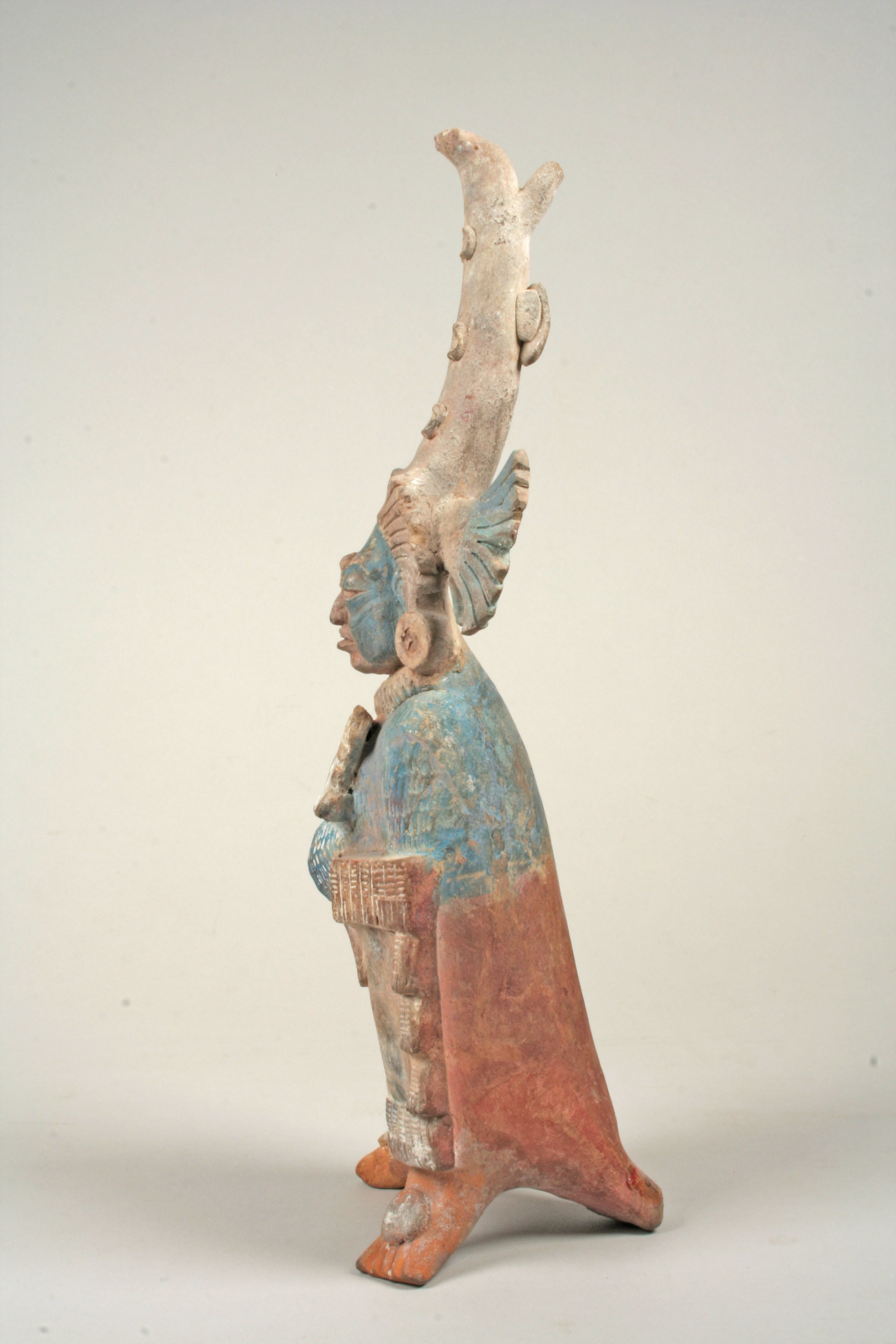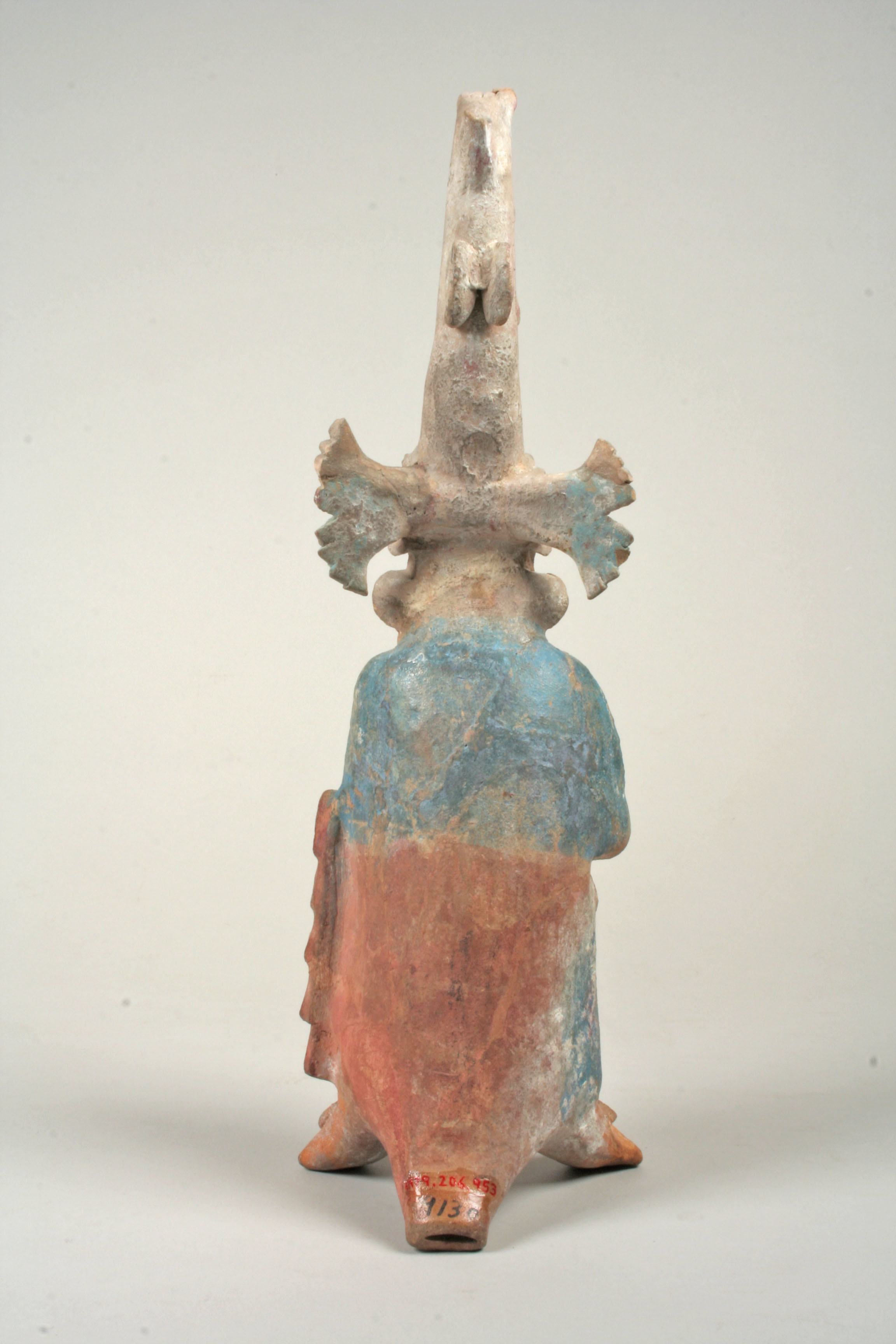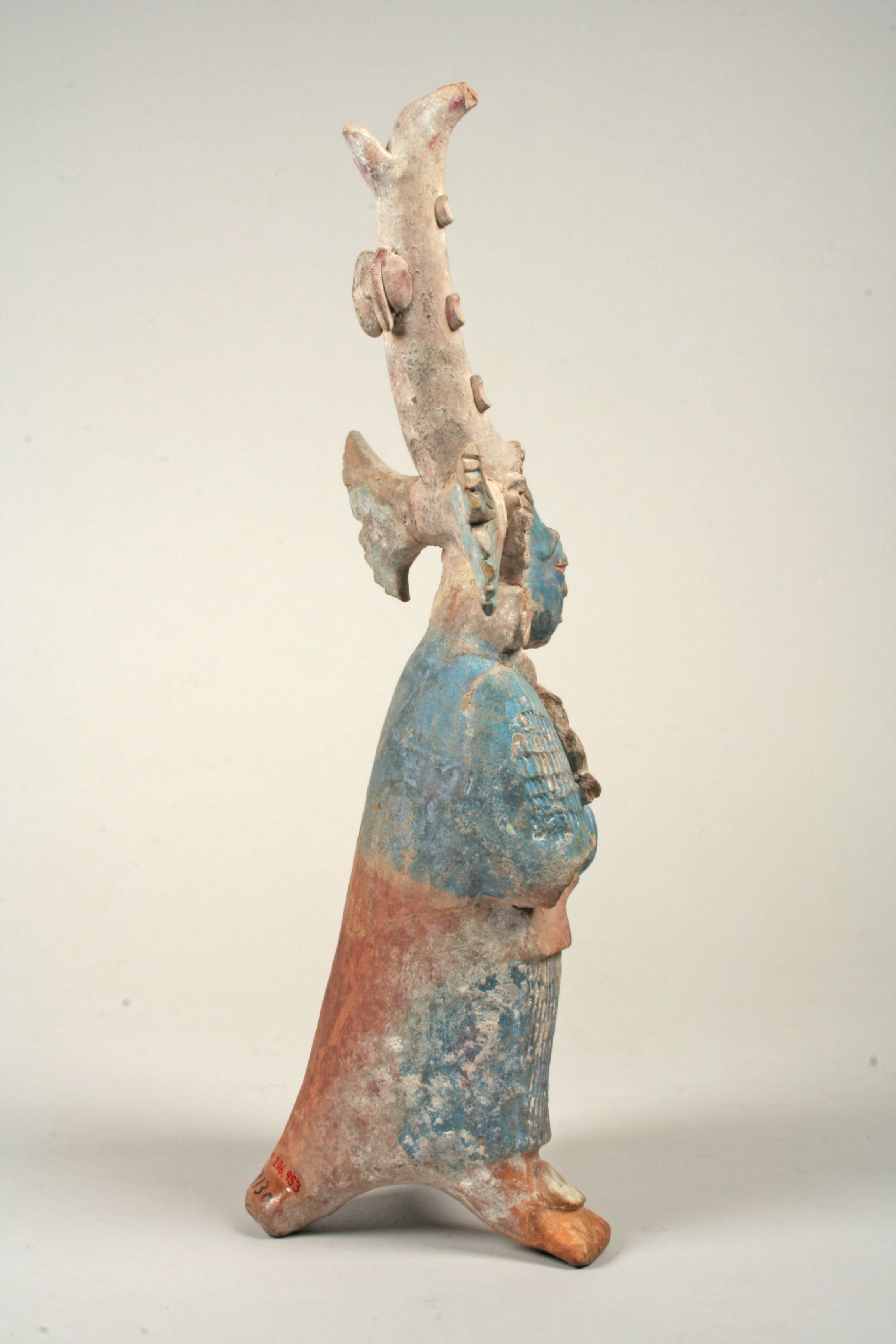Costumed Figure
Not on view
This ceramic figurine depicts a standing male wearing a long textured bodysuit and conical headdress. His mouth is open, as if speaking, and he wears an ornament between his eyes. Incised lines on his cheeks may represent wrinkles, indicating he is a mature individual. He wears a belt and loincloth above the bodysuit, as well as a ruffled collar and large round earflares, or ornaments worn in the earlobes (see 1994.35.591a, b for an example of an earflare set, and 1979.206.1047 for individuals wearing earflare assemblages). His pectoral consists of a large round element with a zoomorphic face emerging from the top right corner. He carries a rectangular shield in his left hand; the shield is marked with patterns that probably represent feathers. The right arm of the figurine is broken at the elbow. This figurine is also a whistle; the mouthpiece of the whistle, visible from the sides and back, serves as a third support so that the figurine can stand erect.
This figurine was made from a mold, with individual characteristics added by hand. Fingerprints, remnants of hand modeling, are visible on parts of the headdress, including the right earflare and the fringes on the left side of the individual’s face. The figurine still retains large swaths of paint, indicating the entire surface would once have been brightly colored. Aside from a central vertical strip, the individual’s face is blue. The textured bodysuit is also blue. The pigment on these sections of the figurine is probably “Maya blue,” a distinctive and durable paint made by heating indigo and palygorskite, a mineral found in clay (see Crocodile Rattle, 1979.206.1143, for another example of Maya blue). The section around the individual’s shoulders is slightly faded and less textured than other parts of the figurine, indicating use wear. The individual’s loincloth and the center of his face were painted red. White paint remains on his pectoral, and on the circular elements atop his feet. The figurine is resolutely frontal: the back of the whistle lacks modeling and texture, and its smooth surface is painted red on the bottom and blue on top.
This figurine is in the Jaina style, named after a small island off the coast of Campeche, Mexico. Jaina was a Maya center occupied from the Late Preclassic period (ca. 300 B.C.–A.D. 250) to the Late Postclassic period (ca. 1200–1500), with a peak population in the Late Classic (ca. A.D. 600–800) and Terminal Classic (ca. A.D. 800–900) periods. A large number of figurines and anthropomorphic whistles similar to this one have been recovered from the island. Like this example, figurines from Jaina are mold made, with individual details added by hand. They depict a variety of subjects, from seated young women to warriors to anthropomorphic beings. While many of these artifacts lack archaeological context, excavations have recovered figurines in the burials of adults and infants. Although this style of figurine is closely associated with Jaina Island, source testing of ceramic material in other museum collections indicates that Jaina-style figurines may have been produced and traded throughout Veracruz, Tabasco, Campeche, and Chiapas, Mexico.
Jaina-style figurines seem to represent ideal “types” of people rather than individual portraits. The portliness of this figure, combined with his heavy jowls and protruding belly, suggest ties with the “Fat God,” a poorly understood character who appears throughout ancient Mesoamerican belief systems. Because his status as a deity is unclear, some scholars, such as archaeologist Christina Halperin, refer to him as the “Fat Man.” First appearing in art from the Preclassic period, the “Fat Man” is a common figurine subject, characterized by his corpulent stomach, sagging jowls, and closed, puffy eyes. The “Fat Man” is associated with humor and musical performance, and in the Classic period he may have been a ritual clown, much like the court jester in Medieval Europe. In some examples he wears a textured bodysuit, dances, and holds a fan. He also appears, as in this figurine, as a warrior with a shield. Christina Halperin (2014) suggests that depictions of the “Fat Man” as a warrior may have been ironic or humorous because they combine the accoutrements of a warrior with someone who is clearly not in fighting shape.
The many incarnations of the “Fat Man” suggest that his meaning may have varied across time and space, however, and that not all portly individuals in Maya art represent this character. Other Jaina-style figurines suggest a more generic designation as a noble or warrior. A similar work in the Cleveland Museum of Art (1963.93) wears a textured blue bodysuit and a removable helmet, and the position of his hands suggests he once carried a spear and shield. Like the Metropolitan figurine, he also has a potbelly. Another figurine in the Jaina style, photographed by Justin Kerr (K1503 in his Pre-Columbian Portfolio), carries a shield with rectangular bands of feathers almost identical to those on the shield of the Metropolitan figurine. In addition, the Metropolitan figurine may represent a local warrior “type” who appears in the art of the Northern Lowlands, especially at Oxkintok and Dscelina. At these sites in Campeche, Mexico, large relief columns depict similar rotund individuals wearing textured bodysuits and carrying shields. The bodysuit most likely represents the quilted armor worn by warriors, while the rectangular shield is carried by warriors in the Usumacinta area. Whether warrior or “Fat Man,” the rich accoutrements worn by this figure underline his noble status.
Caitlin C. Earley, Jane and Morgan Whitney Fellow, 2016
Published references
The Metropolitan Museum of Art. Art of Oceania, Africa, and the Americas from the Museum of Primitive Art. New York: The Metropolitan Museum of Art, 1969, p. 622.
Newton, Douglas, Julie Jones, and Kate Ezra. The Pacific Islands, Africa, and the Americas. New York: The Metropolitan Museum of Art, 1987, no. 91, p. 125.
Garcia Moll, Roberto. “Los Mayas, arte y memoria.” In Mexico en el mundo de las colecciones de arte, Vol. 2, edited by Beatriz de la Fuente. Mexico: D.R. Primera, 1994.
Schmidt, Peter, Mercedes de la Garza, and Enrique Nalda. Maya: Exhibition at the Palazzo Grassi in 1998. New York: Rizzoli International Publications, 1998. Miller, Mary Ellen, and Simon Martin. Courtly Art of the Ancient Maya. New York and San Francisco: Thames and Hudson, 2004.
Further reading
Benavides Castillo, Antonio, and Sara Novelo Osorno. “Rescate de la zona arqueológica Isla de Jaina. In Catálogo de investigaciones INAH 2006,” pp. 26-27. Mexico City: Coordinación Nacional de Antropología, Instituto Nacional de Antropología e Historia, 2006.
Benavides Castillo, Antonio. “Informe de labores arqueológicas realizadas en la Isla de Jaina durante la temporada de 1986.” Revista indigenista latinoamericana I (1998):3-7.
Beyer, Hermann. “A Deity Common to Teotihuacan and Totonac Culture.” Proceedings of the 23rd International Congress of Americanists (1928), pp. 82-84. New York, 1930.
Guernsey, Julia, Sculpture and Social Dynamics in Preclassic Mesoamerica. New York: Cambridge University Press, 2012.
Halperin, Christina T. Maya Figurines: Intersections between State and Household. Austin: University of Texas Press, 2014.
Houston, Stephen, Claudia Brittenham, Cassandra Mesick, Alexandre Tokovinine, and Christina Warinner. Veiled Brightness: A History of Ancient Maya Color. Austin: University of Texas Press, 2009.
Jose-Yacaman, M., Luis Rendon, J. Arenas, and Mari Carmen Serra Puche. "Maya blue paint: An ancient nanostructured material." Science 273.5272(Jul 12, 1996):223.
Miller, Mary Ellen. Jaina Figurines: A Study of Maya Iconography. Princeton: Art Museum, Princeton University, 1975.
O’Neil, Megan E. “Jaina-Style Figurines,” in Ancient Maya Art at Dumbarton Oaks, edited by Joanne Pillsbury, Miriam Doutriaux, Reiko Ishihara-Brito, and Alexandre Tokovinine, pp. 400-403. Washington, DC: Dumbarton Oaks Research Library and Collection, 2012.
Piña Chan, Román. Jaina, la casa en el agua. Mexico City: Instituto Nacional de Antropología e Historia, 1968.
Taube, Rhonda, and Karl A. Taube. “The Beautiful, the Bad, and the Ugly: Aesthetics and Morality in Maya Figurines.” In Mesoamerican Figurines: Small-Scale Indices of Large-Scale Phenomena, edited by Christina T. Halperin, Katherine A. Faust, Rhonda Taube, and Aurora Giguet, pp.236-258. Gainesville: University Press of Florida, 2009.
Triadan, Daniela. “Warriors, Nobles, Commoners and Beasts: Figurines from Elite Buildings at Aguateca, Guatemala.” Latin American Antiquity 18(2007):269-293.
Related objects
Figure with Helmet Mask 1979.206.1150a,b
Standing Male Figure 1978.412.6
Crocodile rattle 1979.206.1143
Standing Figure 00.5.176
Seated Female Figure 1979.206.374
Due to rights restrictions, this image cannot be enlarged, viewed at full screen, or downloaded.
This artwork is meant to be viewed from right to left. Scroll left to view more.





